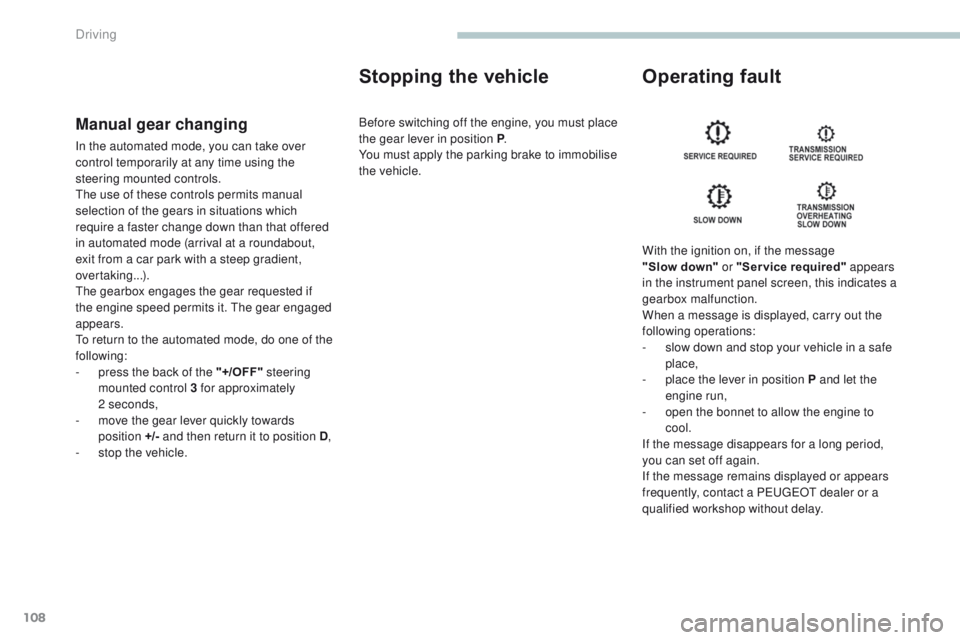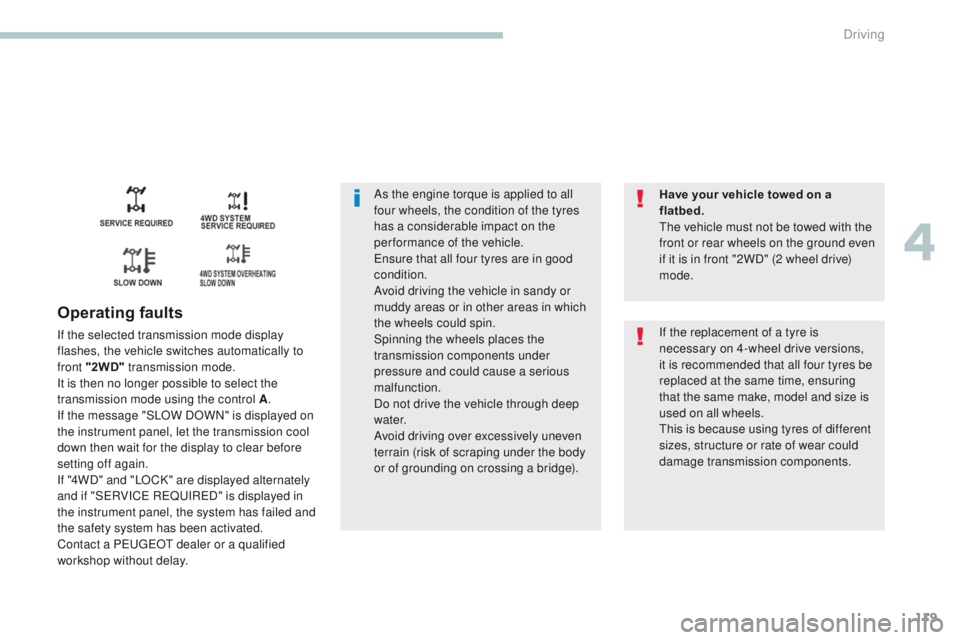Page 83 of 368
81
4008_en_Chap03_Ergonomie-et-confort_ed01-2016
Manual heating / air conditioning
the system operates with the engine running.
1. Temperature setting
F turn the temperature control dial to the right to raise the
temperature, and to the left to
lower it.
to avoid misting and deterioration of the air
quality in the passenger compartment, ensure
that an adequate air flow is maintained.
3. Air distribution setting
F Place the dial in the desired position, to direct air towards:
t
he centre and side vents,
th
e air distribution can be modulated by
placing the dial in intermediate positions.
2. Air flow setting
F turn the dial to the right to increase and to the left to
reduce the air flow.
t
he centre, side and footwell
vents,
t
he footwells,
t
he windscreen, side windows
and footwells,
t
he windscreen and side
windows.
3
ease of use and comfort
Page 86 of 368

84
4008_en_Chap03_Ergonomie-et-confort_ed01-2016
Manual settings
1. Temperature setting
2. Air flow setting
the central and side vents and the footwells,
F
t
u
rn the temperature control
dial to the right to increase the
temperature and to the left to
decrease it.
F
tu
rn the dial to the right to
increase the air flow or to the
left to decrease it.
to
avoid condensation and deterioration of the
quality of the air in the passenger compartment,
ensure that a sufficient flow of air is maintained.
3. Air distribution setting
F Place the dial in the position required to direct the air
towards:
t
he central and side vents,
t
he footwells,
t
he windscreen, the side
windows and the footwells,
t
he windscreen and the side
windows.
th
e air distribution can be adapted by placing
the adjustment dial in the intermediate
positions.
It is possible to set one or more functions
manually while leaving the other functions in
automatic mode.
Switching to manual mode may result in
discomfort (temperature, humidity, odour,
condensation) and does not offer optimum
comfort.
Ease of use and comfort
Page 97 of 368
95
4008_en_Chap03_Ergonomie-et-confort_ed01-2016
Boot fittings
1. Rear parcel shelf (see details on a following page)
2.
S
towing rings
3.
R
etaining strap
4.
S
ide storage
3
ease of use and comfort
Page 98 of 368
96
4008_en_Chap03_Ergonomie-et-confort_ed01-2016
Rear parcel shelfStowing rings
there are four stowing rings in the boot for
securing luggage:
-
t
wo rings are located on the boot floor,
-
t
wo rings are located on the rear side
pillars.to r
emove the shelf:
F
u
nhook the two cords,
F
r
aise the shelf slightly, then remove it.
ther
e are several options for storing the shelf:
-
ei
ther upright behind the front seats,
-
o
r flat at the base of the boot.
Ease of use and comfort
Page 110 of 368

108
4008_en_Chap04_conduite_ed01-2016
Manual gear changing
In the automated mode, you can take over
control temporarily at any time using the
steering mounted controls.
th
e use of these controls permits manual
selection of the gears in situations which
require a faster change down than that offered
in automated mode (arrival at a roundabout,
exit from a car park with a steep gradient,
over taking...).
th
e gearbox engages the gear requested if
the engine speed permits it.
t
he
gear engaged
appears.
to r
eturn to the automated mode, do one of the
following:
-
p
ress the back of the "+/OFF" steering
mounted control 3 for approximately
2
seconds,
-
m
ove the gear lever quickly towards
position +/- and then return it to position D ,
-
s
top the vehicle.
Stopping the vehicle Operating fault
With the ignition on, if the message
"Slow
down" or "Service required" appears
in the instrument panel screen, this indicates a
gearbox malfunction.
When a message is displayed, carry out the
following operations:
-
s
low down and stop your vehicle in a safe
place,
-
p
lace the lever in position P and let the
engine run,
-
o
pen the bonnet to allow the engine to
cool.
If the message disappears for a long period,
you can set off again.
If the message remains displayed or appears
frequently, contact a P
e
uge
Ot
dealer or a
qualified workshop without delay.
Before switching off the engine, you must place
the gear lever in position P
.
You must apply the parking brake to immobilise
the vehicle.
Driving
Page 121 of 368

119
4008_en_Chap04_conduite_ed01-2016
As the engine torque is applied to all
four wheels, the condition of the tyres
has a considerable impact on the
performance of the vehicle.
en
sure that all four tyres are in good
condition.
Avoid driving the vehicle in sandy or
muddy areas or in other areas in which
the wheels could spin.
Spinning the wheels places the
transmission components under
pressure and could cause a serious
malfunction.
Do not drive the vehicle through deep
water.
Avoid driving over excessively uneven
terrain (risk of scraping under the body
or of grounding on crossing a bridge).
Operating faults
If the selected transmission mode display
flashes, the vehicle switches automatically to
front "2WD" transmission mode.
It is then no longer possible to select the
transmission mode using the control A .
If the message "SLOW DOWN" is displayed on
the instrument panel, let the transmission cool
down then wait for the display to clear before
setting off again.
If "4WD" and "LOCK" are displayed alternately
and if "S
eR
VIC
e
R
eQuI
R
eD
" is displayed in
the instrument panel, the system has failed and
the safety system has been activated.
Contact a P
e
uge
Ot
dealer or a qualified
workshop without delay. Have your vehicle towed on a
flatbed.
th
e vehicle must not be towed with the
front or rear wheels on the ground even
if it is in front "2WD" (2 wheel drive)
mode.If the replacement of a tyre is
necessary on 4-wheel drive versions,
it is recommended that all four tyres be
replaced at the same time, ensuring
that the same make, model and size is
used on all wheels.
th
is is because using tyres of different
sizes, structure or rate of wear could
damage transmission components.
4
Driving
Page 126 of 368
124
4008_en_Chap04_conduite_ed01-2016
Vehicle onlyVehicle fitted with a towbar
Modification of the detection
zones
F Press this button to deactivate the system.
F
P ress this button again for a few seconds
and release it.
th
e detection zone modification information is
indicated by an audible signal:
-
d
ouble signal on vehicles fitted with a
towbar,
-
si
ngle signal on vehicles which are not
fitted with a towbar.
Detection zones
the detection zones differ depending on whether the vehicle is fitted with a towbar.
If you select towbar mode, the towbar zone A is excluded from the detection zones.
Driving
Page 127 of 368

125
4008_en_Chap04_conduite_ed01-2016
Visual assistance
Front parking sensors
Deactivation / Activation of the
front and rear parking sensors
the function is deactivated by pressing this
button. th e indicator lamp in the button goes off.
Pressing this button again reactivates the
function.
t
h
e indicator lamp in the button
comes on.
Operating fault
the front parking sensors are triggered when
an obstacle is detected in front, a gear is
engaged (position D for vehicles with a CV
t
gearbox) and the speed of the vehicle remains
below 6 mph (10 km/h).
th
e front parking sensors are interrupted if
the vehicle stops for more than five seconds
in for ward gear, if no further obstacles are
detected or when the speed of the vehicle
exceeds 6 mph (10 km/h). Remember to deactivate the system if
towing a trailer or caravan.In bad weather or in winter, ensure that
the sensors are not covered with mud,
ice or snow.
When the vehicle is moving at a speed
below 6 mph (10 km/h), certain sound
sources (motorcycle, lorry, pneumatic
drill, etc.) may trigger the audible
signals of the parking sensor system.
In the event of an problem, when reverse gear
is engaged this lamp in the button flashes,
accompanied by an audible signal.
th
is supplements the audible
signal by displaying bars in the
screen, in front of or behind the
vehicle. If one of the sensors is faulty, it
flashes in the instrument panel
screen.
Contact a P
e
uge
Ot
dealer or a qualified
workshop.
th
ese bars flash at the start of the manoeuvre
then become fixed from a certain distance
between the vehicle and the obstacle.
4
Driving